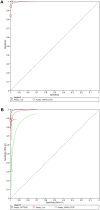Self-Collected versus Clinician-Collected Sampling for Chlamydia and Gonorrhea Screening: A Systemic Review and Meta-Analysis
- PMID: 26168051
- PMCID: PMC4500554
- DOI: 10.1371/journal.pone.0132776
Self-Collected versus Clinician-Collected Sampling for Chlamydia and Gonorrhea Screening: A Systemic Review and Meta-Analysis
Abstract
Background: The increases in STI rates since the late 1990s in Canada have occurred despite widespread primary care and targeted public health programs and in the setting of universal health care. More innovative interventions are required that would eliminate barriers to STI testing such as internet-based or mail-in home and community service testing for patients that are hard to reach, who refuse to go for clinician-based testing, or who decline an examination. Jurisdictions such as New Zealand and some American states currently use self-collected sampling, but without the required evidence to determine whether self-collected specimens are as accurate as clinician-collected specimens in terms of chlamydia and gonorrhea diagnostic accuracy. The objective of the review is to compare self-collected vaginal, urine, pharyngeal and rectal samples to our reference standard - clinician-collected cervical, urethral, pharyngeal and rectal sampling techniques to identify a positive specimen using nucleic acid amplification test assays.
Methods: The hierarchical summary receiver operating characteristic and the fixed effect models were used to assess the accuracy of comparable specimens that were collected by patients compared to clinicians. Sensitivity and specificity estimates with 95% confidence intervals (CI) were reported as our main outcome measures.
Findings: We included 21 studies based on over 6100 paired samples. Fourteen included studies examined chlamydia only, 6 compared both gonorrhea and chlamydia separately in the same study, and one examined gonorrhea. The six chlamydia studies comparing self-collection by vaginal swab to a clinician-collected cervical swab had the highest sensitivity (92%, 95% CI 87-95) and specificity (98%, 95% CI 97-99), compared to other specimen-types (urine/urethra or urine/cervix). Six studies compared urine self-samples to urethra clinician-collected samples in males and produced a sensitivity of 88% (95% CI 83-93) and a specificity of 99% (95% CI 0.94-0.99). Taking into account that urine samples may be less sensitive than cervical samples, eight chlamydia studies that compared urine self-collected verses clinician-collected cervical samples had a sensitivity of 87% (95% CI 81-91) and high specificity of 99% (95% CI 0.98-1.00). For gonorrhea testing, self-collected urine samples compared to clinician-collected urethra samples in males produced a sensitivity of 92% (95% CI 83-97) and specificity of 99% (95% CI 0.98-1.00).
Conclusion: The sensitivity and specificity of vaginal self-collected swabs compared to swabs collected by clinicians supports the use of vaginal swab as the recommended specimen of choice in home-based screening for chlamydia and gonorrhea. Urine samples for gonorrhea collected by men had comparably high sensitivity and specificity, so could be recommended as they can be left at room temperature for several days, allowing for the possibility of mail-in home-based testing. In populations that may not go for testing at all, do not have the option of clinical testing, or who refuse a clinical examination, self-collected screening would be a good alternative. We recommend that guidelines on how to self-collect gonorrhea and chlamydia urine, vaginal, rectal and pharyngeal specimens be published.
Conflict of interest statement
Figures





Similar articles
-
Signs and symptoms to determine if a patient presenting in primary care or hospital outpatient settings has COVID-19.Cochrane Database Syst Rev. 2022 May 20;5(5):CD013665. doi: 10.1002/14651858.CD013665.pub3. Cochrane Database Syst Rev. 2022. PMID: 35593186 Free PMC article.
-
The effect of sample site and collection procedure on identification of SARS-CoV-2 infection.Cochrane Database Syst Rev. 2024 Dec 16;12(12):CD014780. doi: 10.1002/14651858.CD014780. Cochrane Database Syst Rev. 2024. PMID: 39679851 Free PMC article.
-
Clinical symptoms, signs and tests for identification of impending and current water-loss dehydration in older people.Cochrane Database Syst Rev. 2015 Apr 30;2015(4):CD009647. doi: 10.1002/14651858.CD009647.pub2. Cochrane Database Syst Rev. 2015. PMID: 25924806 Free PMC article.
-
The Utility of an Human Papillomavirus Genotype Assay for Cancer Screening in Self-Collected Urine and Vaginal Samples from Japanese Women.Gynecol Obstet Invest. 2025;90(2):143-152. doi: 10.1159/000541641. Epub 2024 Oct 7. Gynecol Obstet Invest. 2025. PMID: 39374596 Free PMC article.
-
Systematic review of the clinical effectiveness and cost-effectiveness of rapid point-of-care tests for the detection of genital chlamydia infection in women and men.Health Technol Assess. 2010 Jun;14(29):1-97, iii-iv. doi: 10.3310/hta14290. Health Technol Assess. 2010. PMID: 20557810
Cited by
-
Understanding Practical, Robust Implementation and Sustainability of Home-based Comprehensive Sexual Health Care: A Realist Review.AIDS Behav. 2024 Oct;28(10):3338-3349. doi: 10.1007/s10461-024-04415-x. Epub 2024 Jul 4. AIDS Behav. 2024. PMID: 38963569 Free PMC article. Review.
-
Comparison of Different Self-Sampling Devices for Molecular Detection of Human Papillomavirus (HPV) and Other Sexually Transmitted Infections (STIs): A Pilot Study.Healthcare (Basel). 2022 Feb 28;10(3):459. doi: 10.3390/healthcare10030459. Healthcare (Basel). 2022. PMID: 35326937 Free PMC article.
-
Sexually transmitted infections among HIV-infected and HIV-uninfected women in the Tapajós region, Amazon, Brazil: Self-collected vs. clinician-collected samples.PLoS One. 2019 Apr 23;14(4):e0215001. doi: 10.1371/journal.pone.0215001. eCollection 2019. PLoS One. 2019. PMID: 31013277 Free PMC article. Clinical Trial.
-
Extragenital chlamydia infection among active-duty women in the United States Navy.Mil Med Res. 2019 Jan 29;6(1):3. doi: 10.1186/s40779-019-0193-x. Mil Med Res. 2019. PMID: 30691524 Free PMC article.
-
Chlamydia trachomatis bacterial load, estimated by Cq values, in urogenital samples from men and women visiting the general practice, hospital or STI clinic.PLoS One. 2019 Apr 19;14(4):e0215606. doi: 10.1371/journal.pone.0215606. eCollection 2019. PLoS One. 2019. PMID: 31002729 Free PMC article.
References
-
- BC Centre for Disease Control (2009) STI/HIV Prevention and Control 2009 Annual Surveillance Report. Vancouver, British Columbia.
-
- BC Centre for Disease Control (2011) STI in British Columbia: 2011 Annual Surveillance Report. Vancouver, British Columbia.
-
- Mayaud P, McCormick D (2001) Interventions against sexually transmitted infections (STI) to prevent HIV infection. Br Med Bull 58: 129–153. - PubMed
-
- Public Health Agency of Canada (2010) Reported cases and rates of chlamydia by province/territory and sex, 1991 to 2009. Ottawa, ON.
Publication types
MeSH terms
Grants and funding
LinkOut - more resources
Full Text Sources
Other Literature Sources
Medical

